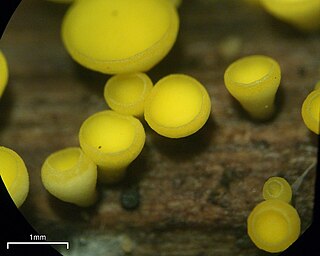
Helotiales is an order of the class Leotiomycetes within the division Ascomycota. The taxonomy within Helotiales has been debated. It has expanded significantly as genomic techniques for taxonomical identification have become more commonly used. As of February 2020, the order is estimated to contain 30 accepted families, 519 genera, and 6266 species.

Chlorociboria is the type genus of in the fungal family Chlorociboriaceae within order Helotiales. The genus includes 23 species.

Chlorociboria aeruginascens is a saprobic species of mushroom, commonly known as the green elfcup or the green wood cup because of its characteristic small, green, saucer-shaped fruit bodies. Although the actual fruit bodies are infrequently seen, the green staining of wood caused by the fungus is more prevalent.

Chlorociboria aeruginosa is a saprobic species of mushroom, commonly known as the green elfcup or the green wood cup because of its characteristic small, green, saucer-shaped fruit bodies. Although the actual fruit bodies are infrequently seen, the green staining of wood caused by the fungus is more prevalent.

Spalting is any form of wood coloration caused by fungi. Although primarily found in dead trees, spalting can also occur in living trees under stress. Although spalting can cause weight loss and strength loss in the wood, the unique coloration and patterns of spalted wood are sought by woodworkers.

Bisporella citrina, commonly known as yellow fairy cups or lemon discos, is a species of fungus in the family Helotiaceae. The fungus produces tiny yellow cups up to 3 mm in diameter, often without stalks, that fruit in groups or dense clusters on decaying deciduous wood that has lost its bark. The widely distributed species is found in North Africa, Asia, Europe, North America, and Central and South America. Found in late summer and autumn, the fungus is fairly common, but is easily overlooked owing to its small size. There are several similar species that can in most cases be distinguished by differences in color, morphology, or substrate. Microscopically, B. citrina can be distinguished from these lookalikes by its elliptical spores, which have a central partition, and an oil drop at each end.

Grifola frondosa is a polypore mushroom that grows at the base of trees, particularly old growth oaks or maples. It is typically found in late summer to early autumn. It is native to China, Europe, and North America.
Chlorociboria albohymenia is a species of fungus in the family Chlorociboriaceae. It is found in New Zealand.
Chlorociboria awakinoana is a species of fungus in the family Chlorociboriaceae. It is found in New Zealand.
Chlorociboria campbellensis is a species of fungus in the family Chlorociboriaceae. It is found in New Zealand.
Chlorociboria clavula is a species of fungus in the family Chlorociboriaceae. It is found in New Zealand.
Chlorociboria colubrosa is a species of fungus in the family Chlorociboriaceae. It is found in New Zealand.
Chlorociboria duriligna is a species of fungus in the family Chlorociboriaceae. It lives in New Zealand.
Chlorociboria halonata is a species of fungus in the family Chlorociboriaceae. It is found in New Zealand.
Chlorociboria macrospora is a species of fungus in the family Chlorociboriaceae. It is found in New Zealand.
Chlorociboria pardalota is a species of fungus in the family Chlorociboriaceae. It is found in New Zealand.
Chlorociboria poutoensis is a species of fungus in the family Chlorociboriaceae. It is found in New Zealand.
Chlorociboria procera is a species of fungus in the family Chlorociboriaceae. It is found in New Zealand.
Chlorociboria spiralis is a species of fungus in the family Chlorociboriaceae. It is found in New Zealand.

Xylindein is a quinone pigment, a dimeric naphthoquinone derivative. It is produced by fungi in the genus Chlorociboria. This pigment causes green staining of wood infected by the fungi.







